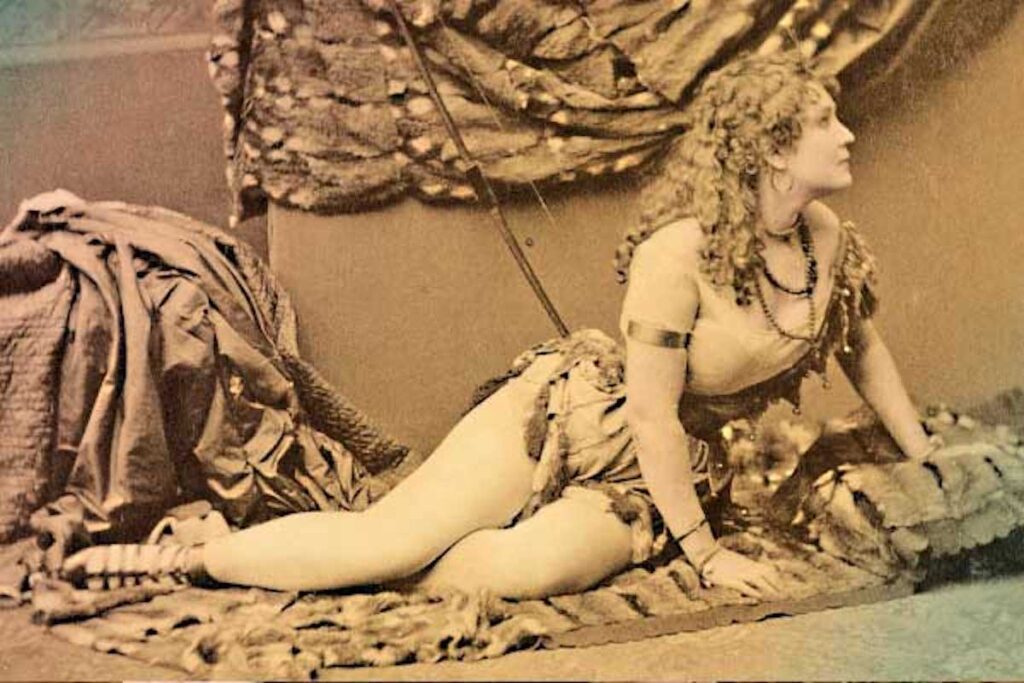
Not all the women who migrated to California during the Gold Rush were prostitutes and gamblers. The women who played the frontier theaters—singers, dancers and actresses—had a head start on the road to success simply because they were women; in much of the West that alone was enough to attract a crowd. There were other ways of getting rich off the earnings of the Forty-Niners. One was acting on stage. In those early days of San Francisco when money flowed as if it came out of a tap,
One of the most popular actresses to come West was Adah Isaacs Menken. “The Menken” as she was called was not a dancer like Lola Montez nor a variety performer like Lotta Crabtree. She preferred melodramas. Although privately, she lived in the “wicked” tradition of Lola Montez, she denied any kinship with her. “She started with a king and ran down the scale to a miner,” She said, ” I began with a prize fighter and I will end with a prince.” She dropped hints of an affair with Sam Houston in Texas, after he saved her from Indians but no proof of that exists.
Ada was born in New Orleans and enshrouded the identity of her parents for many years. She named at least four different men as her father. Her mother was sometimes Creole, sometimes Jewess, and sometimes Franco-Spanish. Actually her father was a “free man of color,” and her mother a Creole. And, she was a beauty. She married a handsome Jewish musician briefly, then married an Irish prizefighter named, John “Benecia Boy” Heenan. They were married only briefly, but he did teach her to box. After that she married another before moving to Paris and becoming the mistress of Alexander Dumas. Then in London she became the mistress of a poet named Swinburne.
She appeared at Maguire’s Opera House in San Francisco in 1862 where she won acclaim and was recognized as a kindred spirit in the local Bohemian colony. The press called her the “Frenzy of Frisco.”
She returned to England to appear in the Mazeppa, a banal dramatization of one of Lord Byron’s poems. The high point came when Menken, in a daring costume was strapped to a horse’s back and rode up a narrow runway between two cardboard mountain crags.
Menken’s was a big hit and that led her back to the American West to her superheated fans in boom towns like Virginia City, Nevada. Colorful posters in Virginia City displayed Menken’s half-naked form upon the back of a black stallion were clinging to the walls of every saloon in town, and the imagination of every miner was set racing.
Opening night the theater was packed with tense, excited males, all waiting for the horseback ride up the mountain peak.
Suspense gripped the miners as stage hands brought the horse to the ramp. Then Menken’s beautiful form was in full view. The miners gaped in astonishment. She rode across the stage stripped of all but a gauzy maillot, the wealth of lovely flesh exceeded their fondest hopes. They heaped gold and silver coins upon the stage in appreciation. The Menken made encore after encore and each time the miners tossed gold and silver coins upon the stage in what had to be one of the most lucrative one-night stands in the history of show business.
On the side the popular Menken put on the boxing gloves with “Joggles” Wright, a Washoe Bohemian with a keen zest for the sport. She finished him off in two rounds. She followed that triumph by defeating two more men with pugilist aspirations.
Kings, poets, buffoons, prizefighters—all fell under her spell for her appeal was elemental. In the bar of the Sazeric, in the place of honor, hung a picture of the Menken, “naked to the pitiless storm.”
The Menken died at the age of 33 in Paris as a result of her wild horseback ride in the Mazeppa, when her leg was gashed as the confused horse ran into the scenery. The wound never healed properly and it developed a cancerous growth which proved fatal, thus ending the life of one of the West’s most colorful entertainers.






